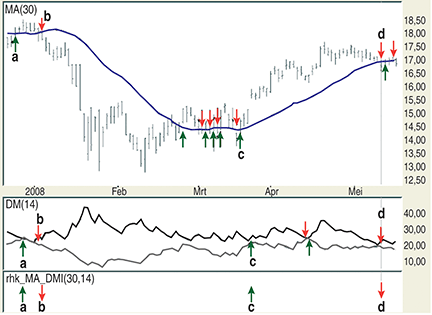TRADING SYSTEMS
Fewer Trades, Better Results
Combining Dmi And Moving Average For A Eur/Usd Trading System
Here is a simple trend-following system where profits are realized in a relatively small number of lucrative trades.
In a world in which we are inundated with information, it is virtually impossible for investors to select the data they need. A trading system based on technical analysis assumes that all available data has been processed in the price history. The system makes its decisions based on this analysis. Untold volumes of information have been written on technical analysis and system trading, which means that scouring the data to select a technique that fits your requirements could end up in a long-drawn-out quest. My advice? Start simple — it’ll get complicated soon enough.
System trading, pros and cons
Investors frequently select indiscriminately from the vast array of
indicators available and choose to swap indicators impulsively,
sometimes even during a position, all too often leading to
disappointment. Thus, it is high time for a more disciplined and
systematic approach. An effective technical strategy suggests objective
entry points, enabling you to disengage your emotions during a position
— provided, of course, you have enough confidence in your trading
system to ensure its successful application.
System trading also has its disadvantages. Sometimes, the system will take positions that run counter to the prevailing market climate. Even the most hardened system traders will find it hard to resist intervening at that point. Morale can also be undermined by a series of losses. Five successive losing trades can be a source of considerable frustration not only financially but also intellectually. It is these moments that require discipline to stay the course.
These days, not many investors invest in only a couple of funds; the importance of spreading risk is now widely recognized. This principle is no less crucial for system trading. Placing all your eggs in one basket is not advisable, so you may want to use multiple systems. In doing so, not only can one system compensate for another’s losses, it can also reduce the risk of having to pay dearly for bad decisions.

Figure 1: moving average and dmi signals. The lower section “rhk_MA_DMI(30,14)” contains signals from combined indicators. The signals a, b, c, and d are composite signals according to the rules. The other signal arrows are false moves from one indicator that are not confirmed by the other. Adding an extra indicator reduces the number of trades.